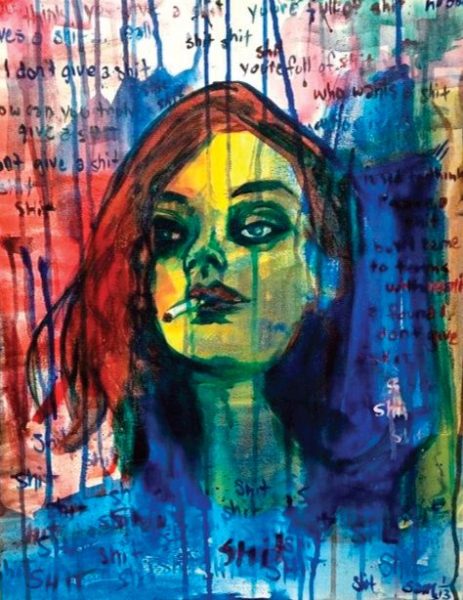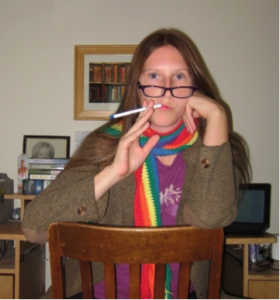In your story, “A Girl Walks into a Page,” you manage to squeeze an astounding amount of breadth and complexity out of a generic joke line, a la “a guy walks into a bar” and “a man walks down the street.” What made you interested in exploring stories as landscapes, rooms, and other kinds of spaces?
Aside from the physicality of falling into an actual page (the section where the girl walks out dripping in ink is, oddly, one of my favorites, despite or because of the fact that it ends with her vomiting ink), I was drawn to the transformative—and sometimes even frightening—impact reading can have on the mind and psyche. I think most readers would agree that the best books, the ones that fully immerse us in their stories, are experienced as living, breathing things.
I have Wendell Mayo’s amazing craft class at the Bowling Green State University MFA program to thank for this story, by the way, which started as a Postmodern exercise. The phrase “a girl walks into a page” came first and wouldn’t leave my brain, and I just went with it.
How important is it that the person venturing into these landscapes is simply “a girl”? What would happen if your protagonist were, say, a fifty-something lesbian mechanic? Or Arohirohi, the Maori goddess of mirages and shimmering heat? Or a pair of conjoined twins, both named Kai?
There’s something about a girl and a book, isn’t there? A little bit of magic. A closeness and an intimacy. The conjoined twins and the mechanic would have their own adventures inside the page, for sure, but to me, the “girl” is a character living out her highest capacity for fantasy and imagination. A girl is powerful and vulnerable at once, and if she falls in love with a book, there’s no separating her from it. She’s all in.
I especially love the eighteen girls simultaneously riding eighteen horses! It so perfectly encapsulates that moment in a tween’s intellectual evolution before she discovers the Brontes. Speaking of which, pick your poison: Jane Eyre or Wuthering Heights. Or do you go further afield for your moody gothic fix?
Is “evolution” the best word for those of us who never fully abandoned our affinity for horse books? But seriously: Jane Eyre. More recently, the last few dark/shadowy/disturbing books I read and loved include The Magic Toyshop by Angela Carter, Untamed State by Roxane Gay, Praying Drunk by Kyle Minor, Tampa by Alissa Nutting, and The Color Master by Aimee Bender. And as far as horse books are concerned, The Hearts of Horses by Molly Gloss.
Let’s change things up with some role-play: I’m a paranoid, aging Luddite. Back in my day, we wrote out drafts in cursive, typed cover letters on our Smith Coronas, and sold fiction in two flavors: novel and short-story. (Some people experimented with novella, usually between stints as squatters in the bathroom of an Orange Julius.) Then Silicon Valley started putting computer chips in everything, and in the snap of a junebug’s wing fiction started shrinking, by gum! Short-short stories, sudden fiction, micronarrative, nanofiction—holy creamed chicken on a waffle! Did I just uncover a conspiracy? What makes short-form fiction so attractive to the gizmo-addled writers of today? Hurry up and answer, or I may start flinging Walkmans and rotary phones at any passersby I see with ear buds.
Well, until last year, I drove a car equipped with only a tape deck, and I actually still had mixed tapes—some recorded from the radio in the ’90s! Shameful. And as a child, I jammed the keys of an ancient Smith Corona before graduating to a fancy electric typewriter, a word processor, and finally a computer. So I get it. I, too, fear my smartphone.
I love reading flash fiction. It’s fun and doesn’t present much of a time commitment. If you are gainfully employed, you can finish reading a flash story before a coworker pops his head over the top of your cubicle to see what you’re up to. Writing flash, though, is somewhat rare for me. Most of my short stories naturally expand to at least the twenty-page mark, and this summer, I’m proud to have successfully cut nearly fifteen thousand words from my novel draft. (Which is also about girls, by the way, with a little bit of magic thrown in. It does not contain deadly paper cuts or vomiting ink, sadly.)
When it comes to the publishing landscape for regular-length stories, I’m a bit disheartened by the apparent trend of shrinking word counts. I know we all have shorter attention spans these days, and that online publication in particular is better suited to shorter pieces, but I love reading a good story, be it two thousand or eight thousand words long. Maybe I’m part of the problem myself; in my work at Mid-American Review, the last few stories I accepted were probably under four thousand words, though I like to think that’s a coincidence.
In conclusion, I’m old and grumpy and I want those kids to get off my lawn.
A bit of literary news from 2012 popped up on my Facebook feed the other day—namely, the discovery of what may be a new daguerreotype of Emily Dickinson. Scholars are excited, since this image seems to show the poet as she was in her mid-twenties, a woman confident in herself and her abilities as a writer. If you could choose one photo of yourself that English professors 150 years from now could pore over, what would that picture look like? What would it reveal about you as an author?
First, I love that daguerreotype. Second, I am camera shy. After a few seconds in front of the camera, my inner self disappears, leaving my eyes as blank as a cartoon character’s. So I can’t imagine what image I’d like to be preserved for posterity. Definitely not this one, which I took as a joke a few years ago while trying to compile as many author photo clichés as possible. Emily Dickinson would be horrified:




 The core workshop of SmokeLong Fitness is all in writing, so you can take part from anywhere at anytime. We are excited about creating a supportive, consistent and structured environment for flash writers to work on their craft in a community. We are thrilled and proud to say that our workshop participants have won, placed, or been listed in every major flash competition. Community works.
The core workshop of SmokeLong Fitness is all in writing, so you can take part from anywhere at anytime. We are excited about creating a supportive, consistent and structured environment for flash writers to work on their craft in a community. We are thrilled and proud to say that our workshop participants have won, placed, or been listed in every major flash competition. Community works.